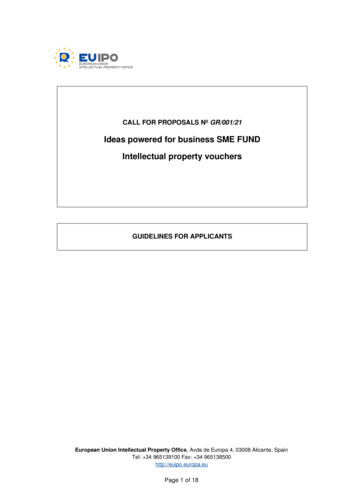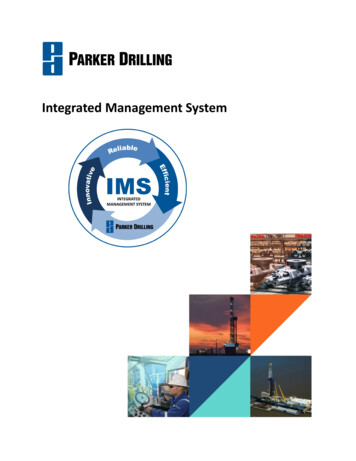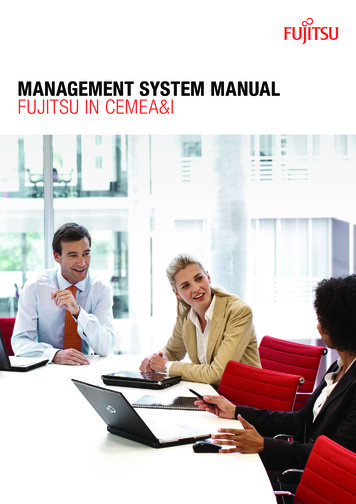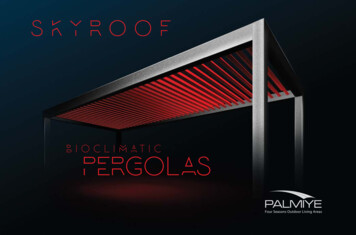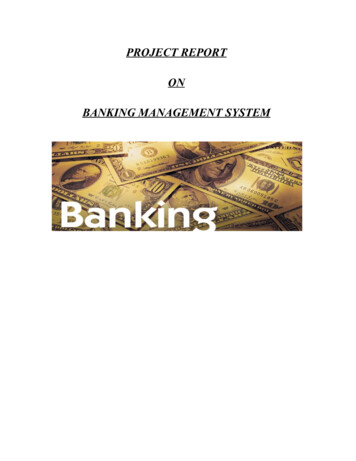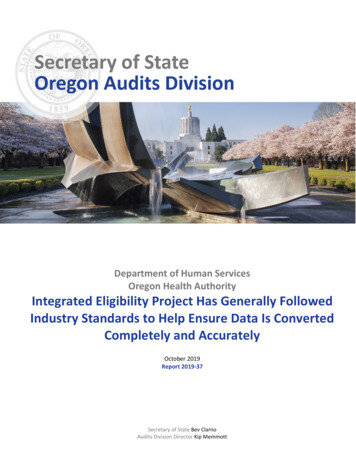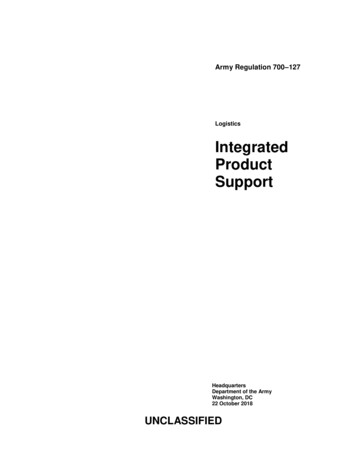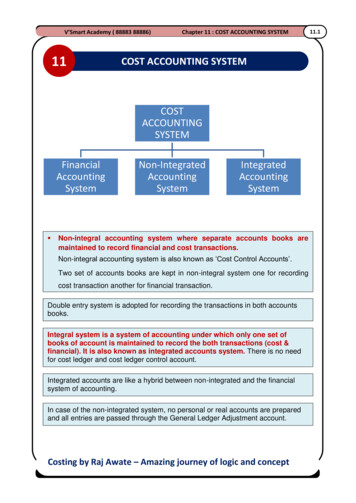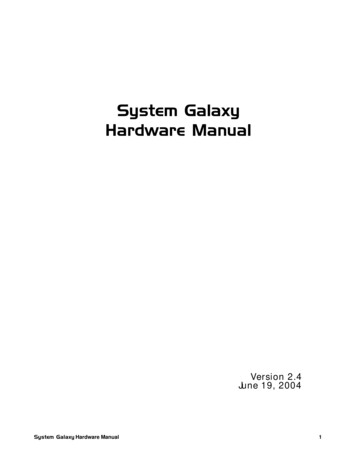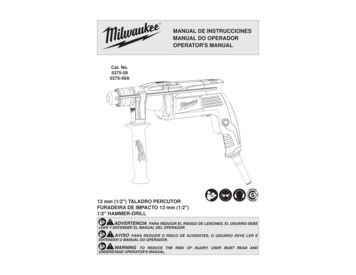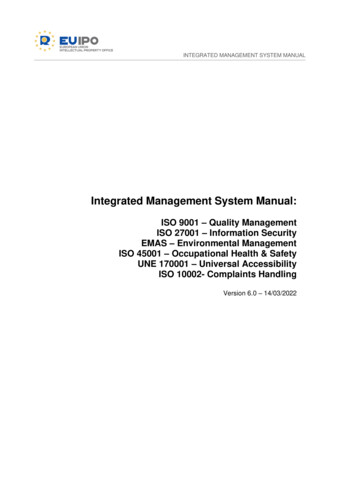
Transcription
INTEGRATED MANAGEMENT SYSTEM MANUALIntegrated Management System Manual:ISO 9001 – Quality ManagementISO 27001 – Information SecurityEMAS – Environmental ManagementISO 45001 – Occupational Health & SafetyUNE 170001 – Universal AccessibilityISO 10002- Complaints HandlingVersion 6.0 – 14/03/2022
INTEGRATED MANAGEMENT SYSTEM MANUALTable of Contents1.INTRODUCTION . 32.CONTEXT OF THE ORGANISATION . 43.4.5.6.7.8.2.1Scope of the Integrated Management System (IMS) . 42.2EUIPO process overview . 5LEADERSHIP AND COMMITMENT . 63.1Integrated Management System Policy . 63.2Organisational roles, responsibilities, and authorities . 63.3Stakeholder management . 7PLANNING AND OBJECTIVES . 84.1Strategic planning . 84.2Management systems planning and objectives . 84.3Risk management system . 9SUPPORT . 95.1Training and awareness . 95.2Communication . 105.3Documented information . 10OPERATIONS . 106.1Operational planning and control . 106.2Requirements of products and services . 116.3Control of non-conforming outputs . 116.4Emergency preparedness and response . 12PERFORMANCE EVALUATION . 127.1Monitoring, Measurement, Analysis and Evaluation . 127.2Customer Satisfaction . 137.2.1Satisfaction Surveys . 137.2.2Complaints . 137.3Audits . 147.4Management Review . 15CONTINUAL IMPROVEMENT . 15ANNEXES . 16EUIPO Integrated Management System ManualPage 2 of 28
INTEGRATED MANAGEMENT SYSTEM MANUAL1.IntroductionThe European Union Intellectual Property Office (EUIPO) Integrated ManagementSystem (IMS) manual presents an overview of the certified management systems at theOffice: ISO 9001 – Quality ManagementISO 27001 – Information SecurityEMAS – Environmental ManagementISO 45001 – Occupational Health & SafetyUNE 170001 – Universal AccessibilityISO 10002 – Complaints Handling.These management systems support the Office in achieving the concrete goals outlinedin both its strategy and its annual work programmes, building upon the principles ofmodern and transparent management, compliance and accountability, customersatisfaction, knowledge sharing, the accessibility of information and sustainability ofoperations. The IMS offers structural support and serves as an accelerant of the movetowards implementing an interconnected and efficient IP system to serve a customerdriven, dynamic, and innovative organisation.The certified management systems are considering using and building upon the variousperformance, governance, internal control, sustainability and other relevant systemsoperating at the Office. An illustrative representation of this interaction is presentedbelow.EUIPO Integrated Management System ManualPage 3 of 28
INTEGRATED MANAGEMENT SYSTEM MANUAL2.Context of the OrganisationThe EUIPO works with ideas, reputations and the shape of things to come. That is theessence of trade marks and designs: they come to life through the brands and productswe love. The EUIPO was created as a decentralised agency of the European Union (EU)to offer Intellectual Property (IP) rights protection to businesses and innovators acrossthe EU and beyond. In addition, the Office’s responsibilities have grown since the originalscope of the European Union Trade Mark and Designs Network was defined. While theOffice’s main focus remains on delivering high-quality products and services to trademark and design users, it also includes activities such as cooperation projects,enforcement support activities and studies related to IP and IP infringement.The EUIPO is a public establishment that enjoys legal, administrative and financialautonomy. The Office was created under European Union law and is a European Unionbody with its own legal personality. The General Court and the Court of Justice of theEuropean Union are responsible for overseeing the legality of the Office’s decisions.The EUIPO focuses on Strategic Plans that span five years, which state the Office’sgoals, following set strategic drivers and identify key initiatives to achieve the strategicgoals. The Office strives to meet stakeholders’ needs and expectations and to make bestuse of resources.To provide excellent services to our users, we need to combine operational efficiencywith a modern and consistent staff policy, respecting diversity and equal opportunity, andcontinue to invest in technology, while also maintaining a high quality and sustainablephysical environment. Therefore, we commit to recognising international managementstandards in quality, complaints, environment, energy, occupational health and safety,information security and universal accessibility.We want to be proactive in our activities management, by assessing and responding torisks according to our Enterprise Risk Management Framework, and by pursuingopportunities that create additional value for our stakeholders, while ensuring ouractivities remain sustainable.With the aim of ensuring the achievement of the objectives of its management systemsas well as guaranteeing the fulfilment of the expectations of internal and externalinterested parties, the Office has identified its main stakeholders based on the analysisof the context covering internal and external issues, such as financial, legal,environmental, economic, technological or organisational aspects.2.1Scope of the Integrated Management System (IMS)The EUIPO has implemented several management systems that have achieved therelevant certification for the fields: Quality Management System (QMS) – ISO 9001Information Security Management System – ISO 27001EUIPO Integrated Management System ManualPage 4 of 28
INTEGRATED MANAGEMENT SYSTEM MANUAL Environmental Management System – EMAS (1)Occupational Health and Safety Management System – ISO 45001Universal Accessibility Management System – UNE 170001 (2)Complaints Handling – ISO 10002.The certifications’ scope includes all the activities, infrastructures and staff of the Office’sheadquarters (located at Avenida de Europa, No 4, Alicante), namely:The processing and management of the European Union (EU) Trade Markand Registered Community Design registration systems, appeal procedures,European and international cooperation, knowledge sharing on enforcementof intellectual property rights, support and management activities.2.2EUIPO process overviewThe EUIPO’s processes are organised into four main areas: Strategic Processes: define the Office’s strategy, governance, including keyactivities such as institutional relations and communication. Business Processes: constitute the Office’s core business and transformcustomers’ & stakeholders’ requirements into services. Supporting Processes: support the whole Office. Evaluation & Continual Improvement Processes: to boost the improvement ofservices or processes.(1) The Office voluntarily follows the guidelines set out in the ISO 50001 standard. However, the implementedenergy management system is not certified by any certification body in accordance with this standard.(2) The scope and exclusions of the universal accessibility management are included in Annex I.EUIPO Integrated Management System ManualPage 5 of 28
INTEGRATED MANAGEMENT SYSTEM MANUALThese processes are described on process cards, which are used for defining anddocumenting activities. The operational activities are described in work instructions andother relevant supporting documentation.3.Leadership and commitment3.1Integrated Management System PolicyThe EUIPO’s commitment to service excellence is communicated and shared withstakeholders in the EUIPO Integrated Management System Policy which unites thedrivers behind the implementation of recognised international management standards.The IMS Policy aims to ensure the integration of the different management systemsrequirements into the whole organisation processes. Moreover, it was the first steptowards the integration of the EUIPO management systems, giving the framework onwhich each standard defines its specific objectives.3.2Organisational roles, responsibilities, and authoritiesThe EUIPO IMS co-exists in a harmonised way contributing to the good performance ofthe Office.Top management is found in the executive director and deputy executive director who,together with the president of the Boards of Appeal, the head of the cabinet, the directors,the heads of internal audit services, communication, corporate governance, the chiefeconomist, and the data protection officer, comprise the Management and AdvisoryCommittee (MAC).The executive director oversees all the certified management systems. The MACmembers are responsible for the effectiveness of the processes implemented in theirareas.The corporate governance service ensures IMS coordination, and the coordination ofeach management system is led by the responsible areas dealing with quality,occupational health and safety, environment & energy, universal accessibility,information security and complaints. Specific interdepartmental forums oversee theactivities related to different standards.The process owners, the Internal Control Correspondents (ICCs), the managementsystems coordinators and other staff facilitate the activities management andcoordination of all the certified management systems. In this way they optimise anddeliver the common requirements as well as sharing valuable information to generatesynergies between them.In each department and service at the operational level, the process owners assist theEUIPO Integrated Management System ManualPage 6 of 28
INTEGRATED MANAGEMENT SYSTEM MANUALexecutive director in defining the organisation’s priorities for achieving the Office’s goalsand supervise the management systems’ functioning to ensure that their performancemeets the Office’s objectives. Each process owner may delegate process supportresponsibilities to others by appointing an Internal Control Correspondent (ICC) as wellas process experts. ICCs work closely with process experts who are individuals withexpertise in relation to specific processes. In addition, ICCs support quality, performanceand risk issues in their respective areas, liaising with the corporate governance service(CGS).ICCs and representatives of the CGS form the ICC network. The network meets regularlyto review plans, activities, communications, and training products. It contributes to thedevelopment, implementation and maintenance of the management systems, includingthe management of performance and risks. The network also participates inbenchmarking initiatives with other European and international organisations.The management systems roles are detailed in Annex II IMS roles description.3.3Stakeholder managementWorking closely with stakeholders has been central to the way in which the Officeconducts its business. The Office’s efforts to increase stakeholder engagement hasintensified considerably over the years.Considering the excellent results achieved to date, and the increasing number ofinterested parties, there is a need to facilitate and coordinate interdepartmental andOffice-wide sharing of information on customers’ and stakeholders’ requirements, needsand feedback.The EUIPO uses its unique position in the IP network to sustain international cooperationby providing easy and inclusive access to all its services. As a consequence of aneffective stakeholder engagement approach, the EUIPO will be perceived as a truepartner among stakeholders that anticipates needs, advocates collaboration, andimplements initiatives with the right and comprehensive approach in the best interest ofusers in the global market.Stakeholders follow a decentralised approach under the executive director’s purview.Specific Office departments perform the stakeholder managers’ role, manage theassigned stakeholders and define the operational procedures to meet both the Office’sand stakeholders’ needs. The stakeholder managers also facilitate the interactionsbetween a particular group of stakeholders and other Office departments, which are notstakeholder managers. In addition, there are specific cases (e.g. administrativeprocedures regarding the seat agreement, relations with the public administrationconcerning facilities management, or contacts with the police) in which the departmentsconcerned contact national public authorities directly.EUIPO Integrated Management System ManualPage 7 of 28
INTEGRATED MANAGEMENT SYSTEM MANUALThe Office has identified the following stakeholders’ groups, which are maintainedaccording to the Office’s needs.EXTERNAL STAKEHOLDERLEADINGDEPARTMENT1.Institutional Stakeholders(National and international IPOs, users associations, EUinstitutions and bodies, international organisations)INSTITUTIONAL nt authoritiesOBSERVATORY4.Academic communityACADEMY5.Suppliers and service providers6.National public authorities not included in point 17.Local community8.Media9.General publicFINANCEINSTITUTIONAL VICECOMMUNICATIONSERVICELEADINGDEPARTMENTHUMAN RESOURCESINTERNAL STAKEHOLDER10.Staff and staff committee4.Planning and Objectives4.1Strategic planningThe EUIPO strategic plan sets the long term planning for the Office. The SP2025 visionfocuses on delivering ‘IP value for businesses and citizens in Europe’.As an IP hub of excellence, the EUIPO provides customer-centric services andcontributes to a stronger IP system, efficient enforcement and better understanding ofIP rights in an increasingly digital global environment by building and promotingsustainable networks, thereby supporting competitiveness, innovation and creativity inthe EU.4.2Management systems planning and objectivesWhen defining and reviewing the management systems’ objectives, the EUIPO takesinto account applicable legal and other requirements to which it subscribes, includingfinancial, operational and business requirements, results of related risks andopportunities assessments, and the analysis of the Office’s context and of its relevantinterested parties. The process of setting the management systems’ objectives alsoconsiders how these objectives influence and impact the objectives of otherEUIPO Integrated Management System ManualPage 8 of 28
INTEGRATED MANAGEMENT SYSTEM MANUALmanagement systems, in order to detect potential synergies and/or points of interactionthat could optimise the results expected for each system.4.3Risk management systemRisk management identifies and assesses potential threats that could affect theexecution of the organisation’s activities and the achievement of its strategic andbusiness objectives. It also identifies opportunities for the Office. The risks are thenprioritised, and when appropriate, actions are taken to reduce them to an acceptablelevel (3). Hence, the aim is not to avoid risks at all costs. It is also about pursuingopportunities that can create value for the Office stakeholders.The EUIPO’s risk management activities follow the Enterprise Risk ManagementFramework, based on the widely accepted Committee of Sponsoring Organisations(COSO) framework for enterprise risk management, adapted to the Office’senvironment, as well as on the European Commission Risk ManagementImplementation guide.The most significant risks for the Office are managed through the Office’s corporate layerand documented in the Office’s corporate risk register. Other risks which are significantfor specific areas are managed through operational layers or specific risksmethodologies (e.g. on information security and occupational risk prevention) whichensure, if applicable, that they are properly escalated to the corporate level. Moreover,they should be documented in operational risk registers or in the IMS processdocumentation following the corporate layer and operational layer approved.5.Support5.1Training and awarenessTo support the establishment of the continual improvement culture within the Office,training and awareness sessions are available throughout the year to all staff. Theseinclude workshops, coaching sessions and e-learning modules in the EUIPO AcademyLearning Portal.The academy encompasses all the learning and educational activities for our staff, staffof the intellectual property (IP) offices of the EU, EUIPO’s users, academia and the publicat large. There is a full training catalogue that covers everything from trade mark toenforcement, as well as non-IP-related matters like language training or soft skills,including management systems modules.Benchmarking activities are carried out in various areas of the Office to identify andimplement best-in-class practices from other organisations. Likewise, manyorganisations come to the Office to learn from our business practices.(3) Except those related to the safety of staff, for which the risk level is zero.EUIPO Integrated Management System ManualPage 9 of 28
INTEGRATED MANAGEMENT SYSTEM MANUAL5.2CommunicationAt a corporate level, the Office’s main communication tool, with its external interestedparties, is the website where all information concerning laws and practices are collatedand all e-services are available. Additional information concerning the Office’smanagement systems performance is also provided through this channel.The Office manages its communication activities related to the IMS following the Office’sapproved processes, aligned with the transparency strategy pursued. IMS information(e.g. the IMS manual, environmental statement) is published and made accessible to theOffice stakeholders.The Office has implemented several communication channels to facilitate the collectionof information from staff, such as suggestion mailboxes, horizontal interdepartmentalgroups, awareness meetings, management and reporting tools. The Office conductssurveys related to the services provided internally to Office staff (e.g. catering, ITservices). The results of these surveys are analysed, and action plans defined to improvethe services.5.3Documented informationAll documents that constitute the IMS are accessible to everyone in the organisation.The IMS documentation comprises the documents that define and support the Office,serve as a tool for communication, give evidence of conformity and enhance knowledgesharing.The documentation hierarchy is structured in different layers – from strategic tooperational documents. Strategic documents are the IMS policy, IMS manual andframework documents. The operational documents are process cards, which describethe overall processes and are cascaded in work instructions and other supportingdocumentation.6.Operations6.1Operational planning and controlThe Office plans, implements and controls the processes needed to meet therequirements for the provision of its products and services.Apart from the long-term vision set out in the Strategic Plans, each year the Officeprepares a Work Programme describing the activities and deliverables defined for theyear. The results and achievements are then reported in the EUIPO annual report.EUIPO Integrated Management System ManualPage 10 of 28
INTEGRATED MANAGEMENT SYSTEM MANUALThe Work Programme is the document that transforms organisational goals intooperational terms. It defines: initiatives/projects to be carried out for each driver and goal;measurable objectives;the service standards to which the Office wants to commit vis-à-vis users;the performance targets that ‘core processes’ must meet to enable compliancewith service standards.The Office has many systems to control the quality, operational effectiveness andefficiency of its processes. Some examples are the performance and risks managementsystems, the product quality checks performed before and after decisions are issued,the internal audits across the whole organisation, and the surveys of stakeholders.The Office has implemented a comprehensive external resources management systemthat supports and promotes an optimal use of external resources, providing valuableinput for the Office’s sourcing decision-making processes.In addition, the Office’s biggest assets are information and knowledge. Therefore, it hasimplemented a knowledge repository, where all documentation and knowledge relatedto Office projects and activities are captured, managed and shared in line with definedpermission rights. Therefore, the knowledge repository is an important element tomitigate the risk of dependence on knowledge from specific individuals (either internalstaff or services provided by external parties) to the smooth functioning of the Officeactivities.6.2Requirements of products and servicesThe Office is committed to complying with the applicable IP, environmental, energy,health and safety, accessibility, information security laws and regulations, as well as withother requirements, including the DALCO (4) criteria for accessibility.The Office ensures that these applicable legal requirements and other requirements towhich the organisation subscribes are considered when establishing, implementing andmaintaining its certified management systems.6.3Control of non-conforming outputsProcesses and supporting documentation include the description of corrective actionsthat the staff should take when they detect an error or deficiency at a specific point in theprocess. In other situations, if a member of staff detects an error or deficiency in aproduct or a service, they should inform their ICC. The ICC will ensure that such reportsare logged in the action log and progressed.(4) The DALCO criteria are Ambulation, Apprehension, Location and Communication. These four parameterssum up the tasks that people perform in their daily interaction with their environment. This, in practice, affectsthings like lifts, wide hallways, stairs, signage, information channels, etc.EUIPO Integrated Management System ManualPage 11 of 28
INTEGRATED MANAGEMENT SYSTEM MANUALThe EUIPO action log is a tool that is used for recording nonconformities, improvements,suggestions, corrective and preventive actions. It complements other EUIPO tools thatare used for managing IT incidents, requests for change, project issues, etc.6.4Emergency preparedness and responseThe Office establishes, implements and maintains the processes needed to prepare forand respond to potential emergency situations concerning health and safety and theenvironment.In addition, the Office has a comprehensive business continuity plan in place that aimsto reduce the risk of disasters, anticipates critical impacts and provides direction tosupport an effective recovery and a return to normal operations. In the case of acontingency, the protection of employees and the business are considered Officepriorities.7.Performance Evaluation7.1Monitoring, Measurement, Analysis and EvaluationThe EUIPO uses a range of reports to support performance management. The EUIPO’s performance management system is a platform where allconsolidated information about indicators and performance measurement of theOffice are published. The balanced scorecard indicators are used to monitor the implementation of thestrategic plan. The EUIPO’s quality service charter defines what users can expect in relation totimeliness, accessibility and the quality of the Office’s products (proceedings anddecisions). Performance against the Quality Service Charter is reported on aquarterly basis on the EUIPO website. An Annual Report is prepared at the end of each year and published on the EUIPOwebsite.The EUIPO operates a variety of quality controls to monitor and report on the quality ofits products and services. The aim is to increase the quality of products and services toensure the EUIPO’s stakeholders’ full satisfaction.EUIPO Integrated Management System ManualPage 12 of 28
INTEGRATED MANAGEMENT SYSTEM MANUAL7.2Customer SatisfactionThe Office aims to fulfil users’ needs and expectations while meeting legal requirementsand making efficient use of resources. The Office gathers users’ opinions concerning theservices it offers through different channels, for example, through immediate feedbacksurveys on e-business tools, panels, meetings with users’ associations and liaisonmeetings.Another important tool to get users’ feedback for the Office is through its informationcentre where all information requests are processed. Through these channels, usersalso make comments and suggestions about the website tools and performance.Furthermore, to make sure that users’ feedback is integrated in how the Office works,the Office has set up systematic processes for surveying users’ needs and dealing withcomplaints.Specific programmes have been established (e.g. the Key User Programme) toencourage them to follow a full e-commerce approach with the Office, covering all ebusiness tools as well as e-communication.7.2.1Satisfaction SurveysA customer satisfaction survey is periodically conducted. The objective of the survey isto identify areas for improvement and to enable the Office to set appropriate priorities toenhance its services and measure the overall satisfaction. In summary, the aim is tocreate a cycle in which user’s needs are used to set improvement goals. Achievementagainst goals is monitored through performance indicators and communicated to users.This then leads to a fresh user input, thus creating a cycle in which the Office continuallyimproves in the direction that its users demand.In addition, the EUIPO may implement an ad hoc satisfaction survey in relation to specificservices from time to time. The main objective is to seek users’ feedback regardingseveral areas to improve the quality of the EUIPO’s services. Users are contacted overa specific period and asked to complete an online questionnaire to measure theirsatisfaction level when interacting with the Office. This provides the EUIPO with rapidfeedback of customer perception, which facilitates a more rapid analysis and reaction bythe EUIPO.7.2.2ComplaintsUsers have the right to complain about any aspect of the activities of the Office. Acomplaint is a written expression of dissatisfaction with the services provided by theEUIPO and/or the EUIPO’s processes. However, the customer department does nothave the competence to answer complaints about the legal reasoning of the decisionsgranted by the EUIPO. In the case of disagreement with EUIPO decisions, an appealshould be filed.The operation of the EUIPO’s administrative procedures can also give rise to complaints.EUIPO Integrated Management System ManualPage 13 of 28
INTEGRATED MANAGEMENT SYSTEM MANUALThe EUIPO ensures effective complaints handling, managing and closing complaints tothe satisfaction of the user in a timely manner. The reporting and analysis of complaintsprovide a key feedback to the EUIPO for improvement.As a result of this analysis, the customer department follows-up on decided actions foramending and/or correcting causes, preventing future complaints based on the samefacts.7.3AuditsInternal audits verify whether working practices comply with the planned arrangementsincluding the processes that govern the activity. Audits identify necessary improvementsand determine if processes are effective and efficient and if responsibilities have beencorrectly assigned.The subject and frequency of the audits depends on the number, importance andcomplexity of the activities to be audited and considers: top management priorities;business risks;the results of previous a
INTEGRATED MANAGEMENT SYSTEM MANUAL Integrated Management System Manual: ISO 9001 - Quality Management ISO 27001 - Information Security EMAS - Environmental Management ISO 45001 - Occupational Health & Safety UNE 170001 - Universal Accessibility ISO 10002- Complaints Handling Version 6.0 - 14/03/2022
